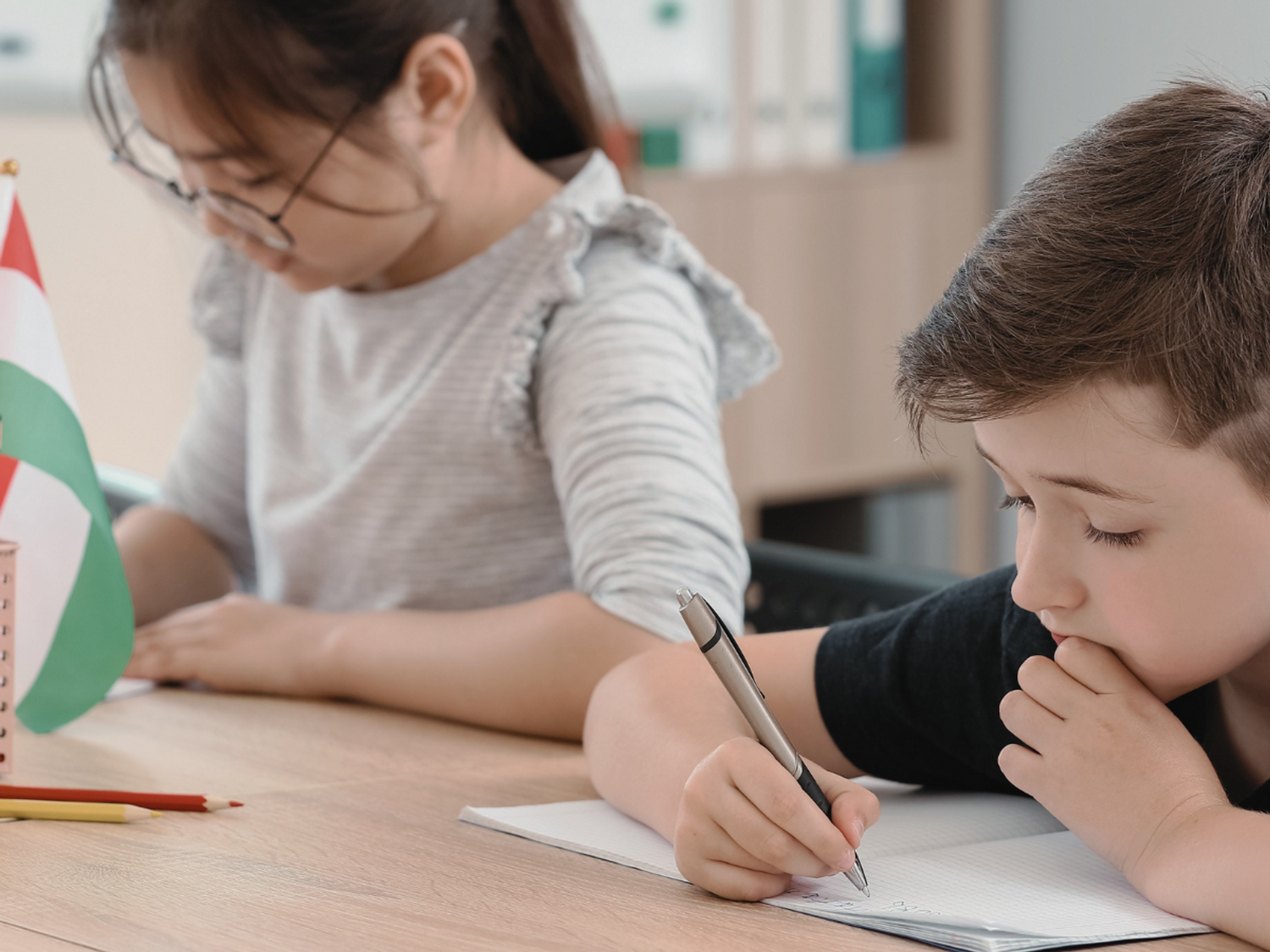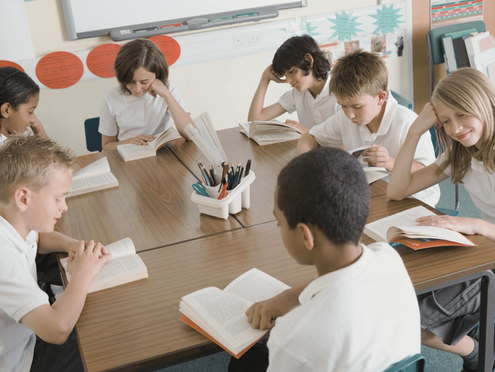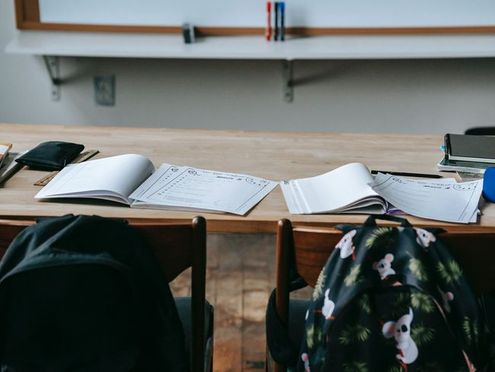Learners can also gain valuable literacy skills in the process. Find out below how learning a new language early in life supports literacy skills.
Learning a new language in primary school
In 2014, the DfE made the teaching of a foreign language compulsory for learners in Key Stage 2 (ages 7-11) as part of its National Curriculum. Schools have free reign to decide on which language they will teach, whether it’s ancient or modern, with the aim of “enabling pupils to make substantial progress in one language.”
This requirement lies on the basis that learning a foreign language during primary years should provide children with a deep understanding of the world and the different cultures within it. More so, it offers young learners an opportunity to develop their literacy skills through both written and oral communication.
In KS2, learners should be taught to:
- Explore the patterns and sounds of language through songs and rhymes, making connections between words and meanings
- Hold conversations in a foreign language to share ideas, express opinions, and ask and answer questions
- Develop an accurate pronunciation of foreign words
- Confidently read foreign texts and display a good level of comprehension and understanding
- Understand the basic grammar and patterns in the language, alongside knowledge of how these differ from English
How can learning a new language help primary learners develop literacy skills?
When learning a new language, it’s easy to focus on subject-specific knowledge (e.g. vocabulary and grammar specific to the language being learned). However, language learning also supports generic literacy skills that can be applied across the curriculum, as well as enabling learners to revisit and consolidate concepts that they originally learned in their first language.
How does learning a new language enhance literacy skills?
- More time spent speaking and listening – Speaking and listening are major elements of language learning, especially in the early stages. While learning another language at school, children get plenty of opportunities to practice oracy skills that are also vital to improving literacy throughout the curriculum.
- Engaging with new texts – Learning a language involves engaging with a wide range of texts, including stories, poems and even text messages. In doing so, they develop their reading comprehension skills in a way that will feed back into their literacy learning. Learners also get opportunities to practise their writing skills and gain familiarity with how languages are structured.
- Comparing two languages – Thinking about how languages are similar or different can spark interest in and insight into key aspects of literacy, so learning another language can give children a new perspective on their own language.
The benefits of learning a second language for literacy are also backed up by research. A study by Murphy et al. (2014), for example, examined three groups of Year 3 students, two of which were learning a foreign language (French or Italian) and one which wasn’t. At the end of the 15-week study, the researchers found that learners who were taught French or Italian outperformed their peers in English reading accuracy and phonological processing.
Language and literacy learning are, in this sense, inextricably related to one another.
What skills do children develop when learning a language?
Learning another language helps children to develop an understanding of how languages work in general. This can then reinforce their understanding of the rules and patterns of their own language, allowing them to apply this knowledge to communicate effectively.
Thus, while some of what children learn while studying a new language is specific to that language (e.g. particular vocabulary), they also get to practise a range of general skills related to oracy (speaking and listening) and literacy (reading and writing).
Oracy skills (speaking and listening)
For young learners, studying a new language will often focus at first on speaking and listening. This includes listening to both the teacher and recordings of native speakers, but it also encompasses activities such as role-plays, conversations, and question-and-answer work.
As a result, learners receive opportunities to develop a range of oracy skills, including:
- Key phonological skills – Studying a new language helps learners to develop key phonological skills, such as the ability to distinguish between familiar and unfamiliar sounds, awareness of how different languages use different sounds, and understanding of how meaning can be gained from phonic information. Such skills can also help children cope with unfamiliar content in their own language.
- Clear pronunciation – Learners gain an understanding of the importance of pronunciation and intonation when studying a new language, which promotes a general awareness of the need to be clear and specific when speaking.
- Listening for communication – When studying a new language, learners develop their ability to listen for both gist and detail. They also get to practise basic listening skills, such as looking at the person speaking and ignoring distractions. This, in turn, can improve their ability to understand and carry out commands and instructions.
- Speaking skills – From single-word responses to reading out full paragraphs, learning a new language provides many opportunities for children to practise their speaking skills, even if they would not usually speak often in other classes. It’s also a great vehicle for developing learners’ conversational skills.
- Non-verbal communication – Mime, gestures and facial expressions can help bring a new language to life, but they also help children to understand how non-verbal communication techniques play a role in oral interactions more generally.
In addition, practising speaking and listening can help to build confidence in learners, which can then be carried over into other areas of the curriculum.
Literacy (reading and writing)
Learning a language also involves a range of reading and writing activities, from engaging with a variety of written texts to composing short sentences and paragraphs. This draws on and reinforces the knowledge learners have gained in their own language.
Language learners are therefore able to develop key literacy skills, including:
- Understanding connections between sounds and letters – Studying a new language, especially the similarities and differences between letter names and sounds in two languages – reinforces alphabetic and orthographic awareness. For example, children learning a language will come to understand the relationships between the sounds used in that language and the symbols used to write it. They can then compare this to their understanding of the same in English.
- Grammar, spelling and punctuation – In learning a new language, children become more aware of how grammar, spelling and punctuation work (and the differences between different languages in these respects). This consolidates the importance of attention to detail when composing a text, especially the value of accurate spelling and punctuation. It also provides opportunities to reinforce knowledge of different word classes, forming questions and negatives, and other grammatical concepts (e.g. gender, singular and plural forms).
- Decoding texts – Studying a new language requires learners to draw on prior knowledge to deduce and decode the meaning of unfamiliar words and phrases. This also gives children opportunities to deploy a range of reading strategies, such as scanning for keywords, connecting text and pictures, and using dictionaries to “solve” unfamiliar aspects of a text and unpack its meaning.
- Reading aloud – Learning a language provides plenty of opportunities to practise reading aloud and to gain confidence in doing so. It can also help to consolidate learners’ understanding of the differences between spoken and written texts.
- Genre awareness – While learning a language, children are typically exposed to a wide range of text genres that they have previously encountered in English, including poems, jokes, stories, simple non-fiction texts and pamphlets. Learners can therefore reinforce their understanding of the different features of each genre (while also gaining knowledge of how text structures and features may differ across languages).
In addition, learning a new language may provide opportunities to engage with aspects of writing that are largely restricted to loanwords in English (e.g. diacritics).
Helping learners transfer skills from language learning to literacy
Studying a second language inherently draws on and reinforces a range of skills related to oracy and literacy - but there are also ways educators can strengthen the connections that exist, helping learners transfer skills from language learning to literacy.
The most appropriate techniques to use will depend on a variety of factors (e.g. the language being taught, the age and literacy level of the learners). However, there are some key areas instructors should keep in mind when developing lesson materials.
Coordinating between subject areas
Perhaps the most important factor in helping learners transfer skills from language learning to literacy is teacher collaboration. Ideally, this will mean language and literacy teachers working together to develop complementary lesson plans.
At a basic level, this might mean simply consulting on the knowledge level of learners. For example, if a language teacher wants to discuss different classes of words (e.g. nouns, verbs, adjectives, adverbs), they will need to know whether learners have covered these concepts in their first language already and adapt their lesson materials accordingly.
But collaboration can also run deeper than this. It can, for example, involve coordinating reading strategies and other teaching techniques, or it may even encompass covering similar topics in both language and literacy teaching (e.g. if literacy lessons involved looking at fairy tales in English, language lessons could use fairy tales as well).
This may require setting aside time and resources for teachers to collaborate. However, cooperation of this kind can enhance broader scaffolding techniques used in the classroom, allowing literacy and language teachers to strengthen previously taught content.
Encouraging learners to use their voices in the classroom
Encouraging children to speak in the classroom is essential for language learning, but the practice they get can also benefit their wider literacy.
Notably, research has found that learners on average only contribute four words per lesson. Since speaking is such a fundamental part of learning a language, it gives learners who would usually be quiet in class a great opportunity to develop confidence and strengthen vital oracy skills.
Speaking in class has also been shown to have a range of wider benefits, such as helping learners to process taught content and making lessons more engaging. Thus, if language learning can be used to encourage children to use their voices in the classroom, it may have a positive influence on their learning experience across the curriculum.
Activities that reinforce skill transfer between languages
It can also be helpful to build lessons around activities that encourage learners to use literacy skills and develop an awareness of the similarities and differences between languages.
These should draw on the literacy and oracy skills discussed above. They should also focus on integrating new language with previously learned language. And while the most suitable activities will depend on the ages and skill levels of the learners, they may involve:
- Listening and responding to songs, poems and stories, with learners asked to listen for particular information or to identify repeated or rhyming words.
- Other games involving focused listening, such as Simon Says and Telephone.
- Developing short role-plays, presentations or performances in pairs or groups.
- Practising writing letters, emails and other types of real-life messages.
- Dictionary games, such as a scavenger hunt in which learners are asked to find words that fit a description, thereby widening their vocabulary.
- Acrostics and other activities that introduce types of creative writing.
- Visual word games that involve reading (and sight words for younger learners). You can also gradually replace visual clues with written ones.
- Responding to verbal questions by air writing words and letters.
- Linking words with shared roots (cognates) in English and the taught language.
- Creating posters and wall displays based on lesson content.
- Asking learners to listen to a story and then repeat or clarify what they hear.
- Rearranging pre-written text and/or pictures to form simple sentences.
- Modelling activities that demonstrate how to form words and sentences.
Activities like these can encourage learners to practise reading, writing, speaking and listening. This will benefit their wider literacy development as well as their language learning.
Language learning and literacy skills
Learning an additional language in primary school is valuable in its own right and provides learners with a greater awareness of the world beyond their home. It can also help children to develop skills that are highly transferable to learning literacy. Likewise, strong literacy skills will help learners thrive when studying new languages (and many other parts of the curriculum), so there is often a virtuous circle between these subject areas.
However, teachers also have a crucial role here. To maximise the benefits of studying a language for primary school literacy learners, it’s important to:
- Coordinate language and literacy learning approaches
- Highlight and reinforce the connections between languages.
- Help learners understand and discuss how languages differ.
- Encourage learners to use their voices in class and develop communication skills.
- Provide exercises that allow learners to make links between languages.
A collaborative approach of this kind can help young children to get the most out of their language and literacy education, setting the foundations for success in learning in the years that follow.




